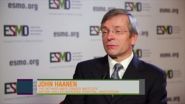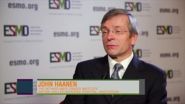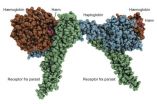Click here for more information.
Lugano/Geneva, Switzerland, 24 November 2014 - High-dose interleukin-2 can be effective in selected metastatic renal cell cancer patients pre-treated with VEGF-targeted agents, reveals research presented today at the ESMO Symposium on Immuno-Oncology in Geneva, Switzerland.
Lead author Dr Manon Evans, research fellow at the Christie Hospital in Manchester, UK, said: "Despite the wide and increasing range of therapies available, the management of metastatic renal cell carcinoma (mRCC) remains challenging. Agents targeting the vascular endothelial growth factor (VEGF) and mammalian target of rapamycin (mTOR) pathways are currently the standard of care. Whilst these therapies are well tolerated and demonstrate impressive response rates, the responses seen are very rarely complete and durable."
She added: "High-dose interleukin-2 (HD-IL2) --a protein that activates the immune system-- can induce durable complete responses in small numbers of patients with mRCC. However, due to significant toxicities, its use remains limited. To date, it has been used as an option in the treatment-naïve population only, with concerns over its efficacy and safety post-VEGF targeted agents."
Given the expanding treatment options now available, selecting the therapy most likely to yield the best long-term response for patients is of increasing importance. Evans continued: "We have previously demonstrated that pre-selecting patients by a combination of clinical and histological criteria can generate impressive results in the treatment-naïve population.1 " Patients were classified as 'Favourable' or 'Other' based on their histological makeup.
The current study is a retrospective analysis of 180 patients treated with HD-IL2 at the Christie NHS Foundation Trust over the past 10 years. The majority were treated in the first-line setting, with a smaller cohort receiving treatment following VEGF-targeted agents. The researchers also investigated whether expression of the biomarker carbonic anhydrase IX (CAIX) correlated with outcome and could potentially be added to the selection criteria for HD-IL2 therapy.
A total of 180 patients with mRCC were treated with HD-IL2, 145 in the treatment-naïve cohort and 35 in the pre-treated cohort. Of these, a total of 158 had 'Favourable' histology of whom over 45% responded with a 23% complete remission rate. Of those achieving a complete response to therapy, over 75% are alive and disease free. The median overall survival in those achieving a complete response has not yet been reached. There was no significant difference in response or survival rate between the two treatment cohorts.
CAIX positivity correlated favourably with response and survival as did disease burden and tolerance of treatment. All patients experienced toxicity as anticipated. The incidence of treatment-related myocarditis was higher in the pre-treated cohort (8.5%) compared to the treatment-naïve group (3.4%).
Evans said: "Our data confirms that there remains a role for HD-IL2 in the management of mRCC and demonstrates, in a selected population, complete responses of over 20%, most of which are durable. In contrast to initial reports, it can be safe and effective in carefully selected patients pre-treated with VEGF-targeted agents with response rates and complete responses similar to first-line therapy. Its application should strongly be considered in both the treatment-naïve and pre-treated population."
She continued: "Outcomes were clearly superior in patients with 'Favourable' histology (incorporating those with solid/alveolar clear cell RCC) but there were rare durable complete remissions in patients with 'Other' histologies and the role of HD-IL2 in this group is less well defined with further assessment required."
Watch the video interview with Prof. John Haanen, Head of Division of Medical Oncology at NKI-AVL, Amsterdam, The Netherlands, commenting on the trial results:
https://www.youtube.com/watch?v=Gr5s8LbkPqU
Commenting on the implications of the findings, Dr Michele Maio, chair of the Division of Medical Oncology and Immunotherapy, Department of Oncology, University Hospital of Siena, Italy, said: "In this retrospective analysis, the use of intravenous HD-IL2 induced complete responses and long-lasting complete responses not only in patients treated first line but also in patients pre-treated with VEGF inhibitors. Until a few years ago, HD-IL2 was the only alternative for patients with mRCC. Today VEGF inhibitors are commonly used in daily practice but we cannot generally obtain long-term responses or long-term complete responses, which are typical of HD-IL2 and immunotherapy in general."
Maio continued: "The authors found that HD-IL2 seems to work in second line to the same extent as it works in first line. This is important for the treatment algorithm of patients with mRCC. One must now consider HD-IL2 as first- or even second-line treatment in patients with mRCC who have a favourable histology. This means that HD-IL2 is still an important drug to be cleverly utilised in the treatment algorithm of patients with mRCC now that we also have VEGF inhibitors available."
"The treatment algorithm of these patients will change again in the near future," added Maio, "because it will include immune checkpoint blocking antibodies, mainly anti-PD-1 and anti-PD-L1 antibodies, that are being actively developed in clinical trials in renal cell carcinoma. This is an additional form of immunotherapy that hopefully will also contribute to the improved long-term survival of these patients."
Maio concluded: "Until a few years ago we had very limited treatment possibilities for mRCC patients. Now we have confirmation that HD-IL2 is still an important option for patients with a favourable histology. HD IL-2 can be very toxic so this is a strategy that is mainly reserved for patients with a very good performance status and it has to be administered by professionals who are experienced with the drug and its side-effects."
INFORMATION:
Notes to Editors
4O - Evaluating the place of interleukin-2 in the management of metastatic renal cell cancer (mRCC) in the era of
targeted therapy".
1 Shablak A, Sikand K, Shanks JH, Thistlethwaite F, Spencer-Shaw A, Hawkins RE. High-dose interleukin-2 can produce
a high rate of response and durable remissions in appropriately selected patients with metastatic renal cancer. J Immunother. 2011;34(1):107-112.
Session info
4O Friday, November 21, 2014 - 17:25 CET.
Disclaimer
Information contained in this press release was provided by the abstracts authors and reflects the content of the studies.
It does not necessarily express ESMO's point of view.
About the European Society for Medical Oncology
The European Society for Medical Oncology (ESMO) is the leading European professional organization committed to
advancing the specialty of medical oncology and promoting a multidisciplinary approach to cancer treatment and care.
ESMO's mission is to advance cancer care and cure through fostering and disseminating good science that leads to
better medicine and determines best practice.
ESMO's scientific journal, Annals of Oncology, ranks among the top clinical oncology journals worldwide. ESMO events
are the meeting place in Europe for medical oncologists to update their knowledge, to network and to exchange ideas.
To find out more about ESMO, please visit: http://www.esmo.org
http://www.esmo.org
Abstract: 4O
EVALUATING THE PLACE OF INTERLEUKIN-2 IN THE MANAGEMENT OF METASTATIC RENAL CELL CANCER
(MRCC) IN THE ERA OF TARGETED THERAPY
M. Evans1, S. Chow1, V. Galvis1, R. Leach2, E. Keene1, A. Spencer-Shaw1, A. Shablak1, J. Shanks1, F. Thistlethwaite1,
R. Hawkins1
1Medical Oncology, The Christie NHS Foundation Trust, Manchester, UNITED KINGDOM, 2The Christie NHS
Foundation Trust, Manchester, UNITED KINGDOM
Introduction: Despite the advent of targeted agents for the treatment of mRCC, HD-IL2 is the only licensed agent
consistently capable of achieving durable long term remissions. Its role in treatment-naïve patients is well recognised but its efficacy and feasibility after VEGF-targeted therapies is less certain. We present outcomes from our experience of
HD-IL2 therapy in both treatment-naïve (Group A) and patients pre-treated with VEGF-targeted therapies (Group B).
Methods: We provide a regional/national treatment service with HD-IL2 for selected patients with mRCC. Selection is
based on clinical and histological features as described by Shablak (Shablak et al., J Immunother. 2011; 34(1):107-12).
180 patients were analysed with 145 in Group A (treated 2003-2013) and 35 in Group B (treated 2007-2013). HD-IL2
was administered as per standard dosing and schedule. Clinical records were reviewed retrospectively; survivals were
analysed by Kaplan-Meir methods.
Results: The majority of patients had 'Favourable' histology with 89% in Group A and 88% in Group B. As previously
reported the outcomes were clearly superior in those with favourable histology but there were rare durable complete
remissions in patients with other histologies. Outcomes in patients with 'Favourable' histology were comparable in both
populations with overall response rates (ORR) and complete response (CR) rates being 47%,23% (Group A) and 42%
19% (Group B). Most CRs are durable and Median OS in CR patients is not yet reached in either group. All patients
experienced expected toxicities associated with treatment. 8 (5.5%) (Group A) and 2 (5.7%)(Group B) of patients were
transferred to critical care for invasive monitoring. 5 (3.4%) patients in the treatment-naïve group developed myocarditis
vs 3 (8.5%) in the pre-treated group - with one treatment related death in (related to myocarditis).
Conclusions: Our results confirm that HD-IL2 remains an effective first-line treatment in well-selected patients with
mRCC providing durable complete remissions in over 20% of patients. While cardiac toxicity appears higher in pretreated
patients, HD-IL2 in this setting is effective, tolerable and can produce durable remissions comparable to those
seen in the first-line setting. With the introduction of increasing numbers of therapies (including new immune therapies) for the treatment of mRCC it is important to make the best use of all treatments and to combine / sequence therapies to maximise the chance of durable benefits for patients.
Disclosure: All authors have declared no conflicts of interest.
Keywords: HD-IL2, interleukin-2, metastatic renal cell cancer
Media contact
ESMO Press Office
E-mail media@esmo.org




